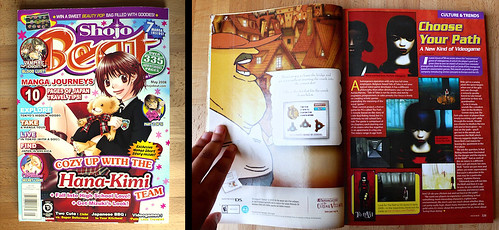I enjoy playing Endless Ocean. Not as much as reading a good novel or attending a nice opera. But more than any game that has been published in the last few years. I realize that this tells me more about the quality of those other games than it does of that of Endless Ocean.
Eurogamer’s review of Endless Ocean once again shows how inadequate games journalists are in reviewing games that are different. Within the context of a hardcore games publication, it probably makes sense to almost exclusively talk about the gameplay. And I think that anybody who judges Endless Ocean on its gameplay would arrive at the same low score (6). But is gameplay really the only thing that matters in a contemporary game? Have we come this far, developed all this technology, spent all these millions, just for some mechanic?
Perhaps Eurogamer’s audience consists exclusively of hardcore gamers. And Eurogamer may feel an obligation to view everything through the eyes of a hardcore gamer. Even if the majority of people who end up buying and playing the games they review do not fit in this category. But this is also a self-fulfilling prophecy. If you only talk about games from a hardcore perspective, other players will simply not be interested in what you’re saying. Or they would have to be as cynical as yours truly and scan for the word “boring” as an indication of a game that they might like.

Meanwhile the majority of gamers have no place to go. Mainstream magazines don’t have the space. And specialist magazines cater to the small hard core exclusively. With the ever-expanding reach of the games medium, the need for a non-hardcore games press becomes more and more urgent. The audience is ready. The publishers are ready. The developers are ready. But the press is lagging behind. This is holding back the industry because we all still care about what the press says. Even if we think that they only half-know what they are talking about. And even if we know that game reviews and game sales are two entirely different things. We still care. For one thing, press has an enormous effect on a publisher’s greenlighting process.
It’s amusing to hear Eurogamer express the exact same sentiment about Endless Ocean as I have felt when playing Bioshock or Portal or Zelda or Mario or World of Warcraft:
After sitting for minutes at a time, gently shaking the Wii remote to and fro over a digital rendition of a Red Gurnard or Bigeye Trevally, you do have to ask what you are doing with your life. As a hobby, brass-rubbing makes more sense.
Brass-rubbing. Or pretending to run around as a space marine in a science station on an alien planet? Or hitting endless series of excessively large insects on the head so that a number in the corner of your screen would increase? Or making a little dwarf jump from one platform to another so that he can jump on another and sometimes on another character’s head?
When a game makes you feel that you are wasting your time, is when you stop playing. But the point where this happens, is very different for different people.
It seems to me that hardcore gamers are well aware of the futility of the games that they play. But they want the game’s design to continuously distract them from this fact. It is the purest form of escapism: a game that absorbs you completely and doesn’t allow your brain any time to reflect on what you’re doing. Eurogamer literally complains about the fact that the designers of Endless Ocean are too gentle in this respect.
But what if you like being treated gently? What if you don’t hate your life and you don’t want to be knocked unconscious by your entertainment? What if you just want to relax in front of the television set, doing not much of anything, spending some time with your family, experiencing a story or looking at pretty moving pictures?
Eurogamer talks about a games’ pull, about it being compelling, about goals and gathering and collecting, incentives and rewards, and mini-games. But is this really why people play Endless Ocean? Why they like playing it? Reviews of games like this need to go a bit deeper. Or somewhere else. Just saying that the hardcore gamer will not like Endless Ocean -which is essentially what the Eurogamer review does- is not very informative or helpful.
And it’s not like they don’t realize this:
It’s an honest relief to play something that doesn’t shout in your ear, set any time limits, or feature a single explosion; a game whose raison d’être is just beauty and peace. Playing this game is almost like taking a holiday from gaming.
It’s that they don’t appreciate it. And apparently don’t care that other people do.


